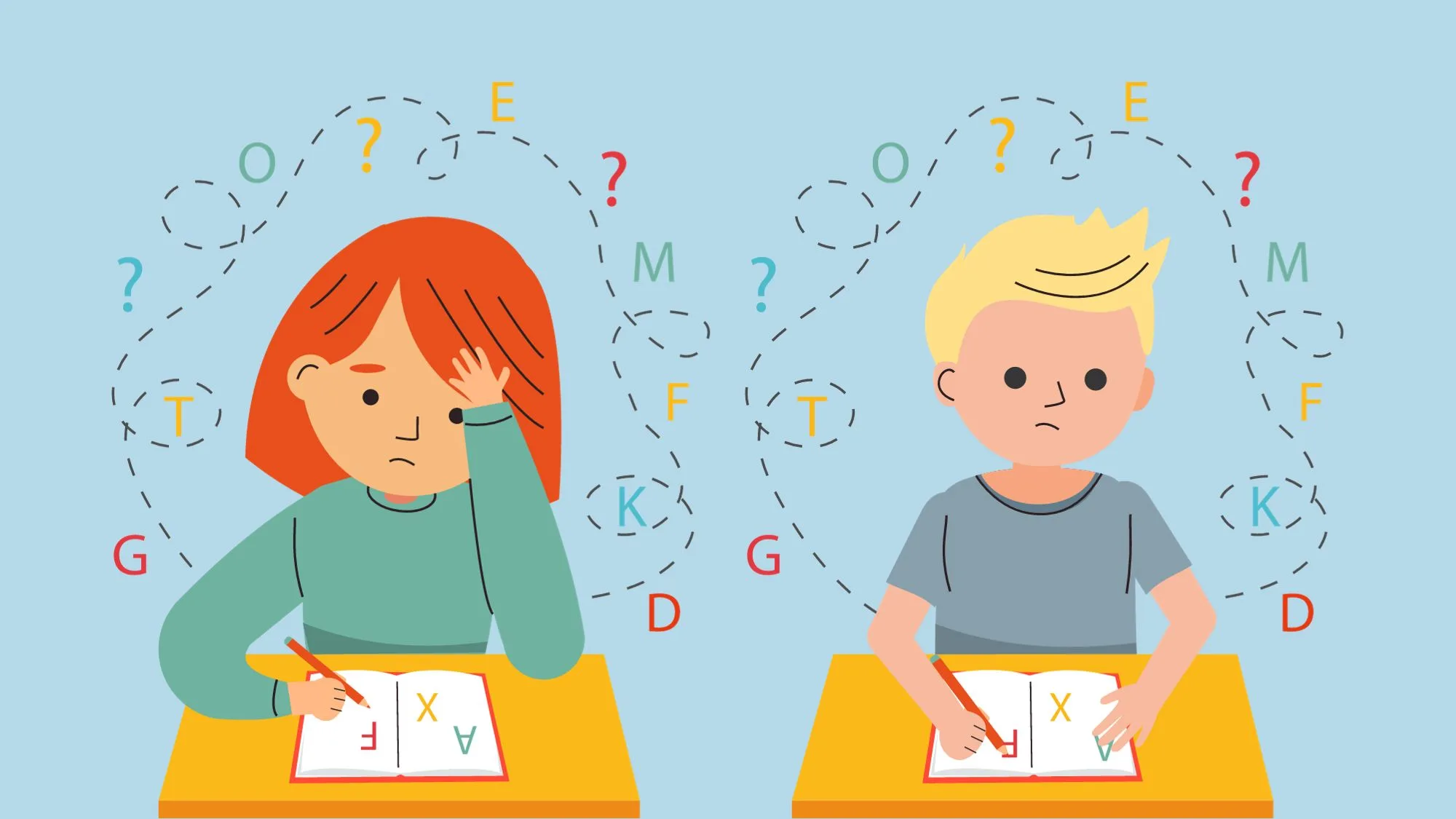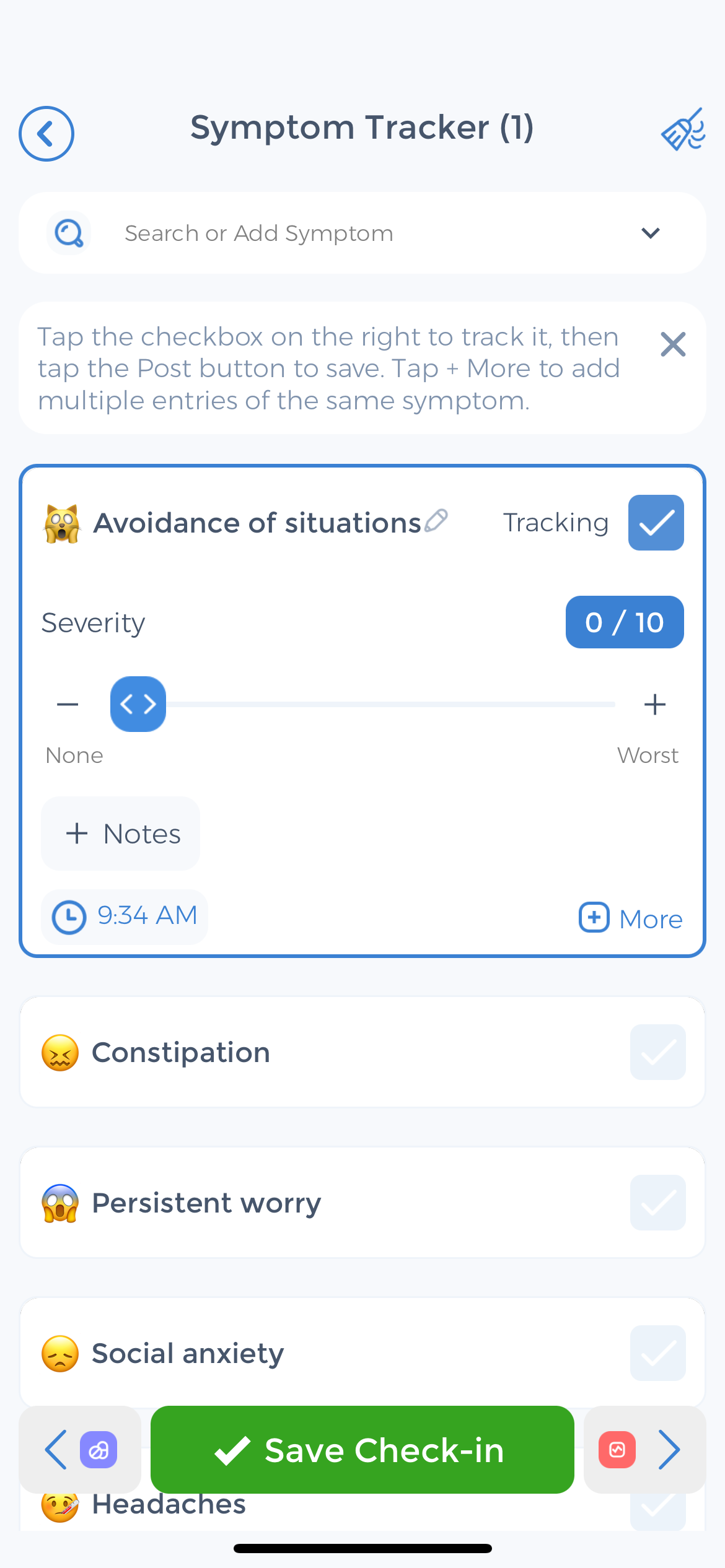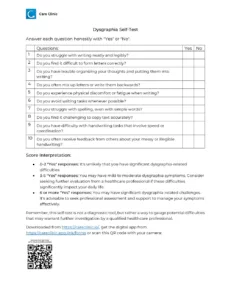
You struggle to put your thoughts down on paper clearly and coherently. Even though you have no issues expressing yourself through omitting words. Writing tasks that should take minutes end up occupying hours of your time as you laboriously work to translate the ideas in your head into written words on the page.
If this experience sounds familiar, you may have dysgraphia, a learning difference that affects your ability to write. The impacts of dysgraphia range from messy handwriting to challenges organizing and expressing thoughts in writing.
Dysgraphia is manageable. By taking an online dysgraphia test or screening, you can identify if you may have this condition and access targeted interventions to strengthen your writing skills.
Table of Contents
- Why You Should Take an Online Dysgraphia Test?
- Printable Dysgraphia Test
- An Overview of Dysgraphia
- What is Dysgraphia?
- Common Signs and Symptoms of Dysgraphia
- Seeking an Official Dysgraphia Diagnosis
- Dysgraphia Interventions and Accommodations
- FAQs About Dysgraphia Testing
- Takeaways from the Online Dysgraphia Test
- Take Another Neurodivergent Test
Why You Should Take an Online Dysgraphia Test?
Taking an online dysgraphia test can help determine if you or your child have dysgraphia. Early diagnosis and intervention are key to managing dysgraphia and helping to improve writing skills. An online screening test can provide initial insights into potential signs of dysgraphia before seeking a full assessment from a professional therapist.
Some indicators of dysgraphia that may be uncovered through an online dysgraphia test include
- Difficulty organizing thoughts on paper or typing on a keyboard. Individuals may have trouble structuring sentences, paragraphs, and overall flow or sequencing.
- Messy or illegible handwriting despite average or above-average fine motor skills. Writing requires a complex set of cognitive, language, and motor skills which can be impacted with dysgraphia.
- Difficulty with syntax, sentences, punctuation, and spelling. Translating thoughts into written words in a coherent manner can be challenging. •
- Avoidance of writing tasks. Due to the difficulties, those with dysgraphia may avoid writing whenever possible which can impact performance in school and work.
- Slow or laborious writing. The physical act of writing or typing may require an inordinate amount of effort, concentration and time.
- Inconsistent skill level. Writing abilities may fluctuate day to day or even within the same writing task. Some days or parts may be illegible while other days or parts are adequate.
If indicators of dysgraphia are detected in the online screening, it is recommended you consult a professional therapist for a full assessment. A diagnosis of dysgraphia will enable you to take advantage of resources and accommodations, as well as strategies and interventions to strengthen writing skills. The earlier the diagnosis, the sooner strategies can be put in place to help minimize challenges and maximize potential.
Dysgraphia requires patience and practice. With the right strategies and support, writing abilities can be significantly improved. An online dysgraphia test is a helpful first step toward getting the help you or your child needs.
Printable Dysgraphia Test
⬇️ Printable Dysgraphia Tesy PDF
What to Expect From a Dysgraphia Test
To know if you have dysgraphia, you or children will need to undergo an evaluation by an occupational therapist, speech language pathologist, or other qualified professional. The evaluation will assess your writing skills and learn if they are significantly below what is expected for a child your age.
The evaluation typically consists of a series of standardized tests as well as writing samples. You will be asked to copy text, take dictation, and generate spontaneous writing samples. The evaluator will analyze factors such as your letter formation, spelling, punctuation, fluency, coherence, and legibility. They will also consider your writing posture, grip, and speed. The results are then compared to normative data for your age to identify if there are any clinically significant differences.
An Overview of Dysgraphia
Dysgraphia is a learning disability that affects a person’s ability to write coherently. Individuals with dysgraphia struggle with the physical task of writing and spelling, as well as organizing thoughts on a paper. A dysgraphia test can help determine if you have dysgraphia.
What is Dysgraphia?
Dysgraphia makes the act of writing difficult. It can affect fine motor skills needed for proper pencil grip and movement. As well as visual-spatial skills required to organize letters and words on a page. Those with dysgraphia may write very slowly, have poor handwriting, and struggle with spelling. Writing requires a complex set of cognitive, language, and fine motor skills, so challenges in any of these areas can lead to dysgraphia.
Common Signs and Symptoms of Dysgraphia
- Messy, illegible handwriting despite trying your best.
- Difficulty organizing thoughts on paper.
- Trouble with spelling and grammar.
- Slow or laborious writing.
- Difficulty with pencil grip.
- Tend to avoid writing whenever possible.
Dysgraphia can manifest itself in a variety of signs and symptoms. Some of the most common indicators that a person may have dysgraphia include
Illegible Handwriting
Someone with dysgraphia typically has very messy handwriting that can be nearly impossible for others to read. Their handwriting may be small objects uneven in size and shape, with letters that are also small objects not formed clearly.
Trouble Organizing Thoughts
Individuals with dysgraphia often struggle to organize their thoughts in a logical sequence. This can make the act of writing lengthy, complex pieces very challenging. They may frequently get off-topic or have trouble coherently structuring paragraphs and essays.
Difficulty with Spelling
People with dysgraphia frequently struggle with spelling. Especially when writing. They may make frequent, spelling errors or mistakes. Even on common words, or have trouble remembering the correct spelling of words. Spelling skills without dyslexia often do not match a person with dyslexia’s verbal abilities.
Slow or Laborious Writing
The actual act of writing can be arduous for those with dysgraphia. It may take them a long time to write a one letter size or short piece. As they struggle to form letters and get their thoughts down on paper. Their writing may appear very deliberate as if they have to concentrate on each letter.
Trouble with Syntax and Grammar
Proper syntax, grammar, and punctuation rules are often problematic for people with dysgraphia. They may frequently make mistakes with sentence structure, verb tenses, punctuation use, and other writing conventions. Their writing can seem immature for their age and education level.
Avoid Writing
 Some individuals with dysgraphia avoid writing whenever possible due to the significant challenges and frustrations it poses. They may procrastinate or put off writing tasks, especially lengthy or complex ones. Writing anxiety and a sense of inadequacy are common in people with dysgraphia.
Some individuals with dysgraphia avoid writing whenever possible due to the significant challenges and frustrations it poses. They may procrastinate or put off writing tasks, especially lengthy or complex ones. Writing anxiety and a sense of inadequacy are common in people with dysgraphia.
If several of these signs and symptoms seem familiar, an evaluation for dysgraphia may be warranted. A formal diagnosis can help identify appropriate interventions and accommodations to support writing skills.
Dysgraphia is a lifelong condition, but interventions and accommodations can help make writing more manageable. These include occupational therapy focused on handwriting. Using a keyboard instead of writing by hand, speech-to-text software, and extra time for assignments.
If you suspect you or your child may have dysgraphia, taking an online dysgraphia test can help provide more insight. These tests evaluate skills like handwriting, spelling, grammar, and fine motor capability to identify if and how dysgraphia may be impacting your child’s writing ability. The results can then help guide the next steps for evaluation, resources, and strategies to support your child’s writing needs.
Dysgraphia is a specific learning disorder that may make the physical act of writing and organizing thoughts on paper challenging. However, with proper support and accommodation, individuals with dysgraphia can develop effective writing and speaking skills. Testing for dysgraphia is an important first step to getting the help needed.
Seeking an Official Dysgraphia Diagnosis
Seeking an official dysgraphia diagnosis can help identify appropriate interventions and accommodations. A diagnosis provides validation and helps guide treatment options to best support someone with dysgraphia. There are several ways to pursue a dysgraphia diagnosis.
Standardized Testing
Standardized tests administered by an occupational therapist, speech language pathologist, or other professional can help identify if dysgraphia is present. Tests like the TOWL-4 (Test of Written Language) measure writing speed, accuracy, and fluency to identify potential indicators of dysgraphia. Scoring significantly below average for one’s age or grade level may point to dysgraphia.
Informal Assessments
Informal assessments to diagnose dysgraphia often involve evaluating handwriting samples, writing fluency, and skills like spelling, grammar, and punctuation usage. An assessment to diagnose dysgraphia may determine how long it takes to copy or write spontaneously, examine letter formation and sizing, measure spacing between words, and evaluate coherence and sequencing. Difficulty with these types of measures could signify dysgraphia.
Multi-disciplinary Evaluation
A comprehensive evaluation involving multiple professionals may be needed to either confirm or rule out a dysgraphia diagnosis. This can include assessments by occupational therapists, speech-language pathologists, psychologists, and others. Input from teachers and parents regarding the individual’s writing challenges and abilities is also often considered. A multi-disciplinary team is best equipped to evaluate the range of factors that can contribute to dysgraphia.
Accommodations and Interventions
Once diagnosed, appropriate accommodations and interventions for learning disabilities can be put in place, such as extra time for assignments, use of speech-to-text software, tutoring, and occupational therapy. Early intervention and remediation are key to helping improve writing skills and build confidence. A diagnosis of dysgraphia means writing difficulties are due to a learning disability or difference, not a reflection of intelligence or effort. With proper support and strategies, individuals with dysgraphia and learning disabilities can achieve their full potential.
Dysgraphia Interventions and Accommodations
Dysgraphia interventions and accommodations aim to help improve writing skills and make the writing process easier. Several options are available depending on your needs and learning style.
Assistive Technology
Assistive technology like speech-to-text software, word prediction programs, and spell checkers can help with the physical act of writing. Speech-to-text software allows you to speak into a microphone and have your words transcribed. Word prediction suggests words and phrases as you type to reduce keystrokes. Spell checkers identify potential spelling errors. These tools can make writing less frustrating and time-consuming.
Modified Instruction
Modified or explicit instruction in handwriting, spelling, written language and written expression can help remediate writing skills. Occupational therapists provide guided practice and tailored strategies for holding a pencil, forming letters, and building fluency. They may also recommend useful apps, workbooks, and exercises to practice at home.
Accommodations
Accommodations do not change what is being taught but instead change how it is accessed or assessed. Things like allowing extra time for written work, reducing written workload, allowing oral responses instead of written ones, and providing written outlines or graphic organizers are an example of all useful accommodations for dysgraphia.
Alternative Assessments
Using alternative assessments instead of or in addition to essays, written reports, or other lengthy written assignments may be appropriate. Things like oral presentations, video presentations, art projects, or posters can allow you to demonstrate knowledge and skills without relying solely on writing.
With the proper interventions, strategies, and accommodations in place, the challenges of dysgraphia can be significantly reduced. The key is finding what works for your unique situation and learning needs. Don’t be afraid to try different options or combinations of options to optimize your success and comfort with writing.
FAQs About Dysgraphia Testing
Many individuals who struggle with writing may wonder if they have dysgraphia, a specific learning disorder or difference that impacts a child’s handwriting and capability to write. To identify if you or your child may have dysgraphia, taking a formal dysgraphia test can be helpful. Here are some frequently asked questions about dysgraphia testing:
What does a dysgraphia test evaluate?
A dysgraphia test examines skills required for proficient writing like language processing, motor skills, visual-spatial skills, and more. It will evaluate things such as handwriting, spelling, punctuation, grammar, and the ability to organize and express thoughts in writing.
The specific skills tested can vary but typically include:
- Handwriting speed and legibility
- Spelling accuracy
- Usage of sentences
- Punctuation correctness
- Ability to organize thoughts in a logical sequence
What are the benefits of getting tested for dysgraphia?
A formal dysgraphia test can identify if writing difficulties are due to dysgraphia or another issue. An accurate diagnosis leads to appropriate interventions and strategies to help improve skills. It also helps in developing an individualized education plan (IEP) or 504 plan to support a student’s needs. Knowing the specific ways dysgraphia impacts an individual allows for targeted remediation and accommodations.
Dysgraphia testing evaluates a range of skills required for proficient writing to identify if and how dysgraphia may be impacting an individual. Conducted by professionals, it provides an accurate diagnosis and foundations for appropriate support. For many struggling with writing, dysgraphia testing can be a crucial first step to unlocking their potential.
Takeaways from the Online Dysgraphia Test
If you or someone you know struggles with handwriting, spelling, or translating thoughts into the written word, taking an online dysgraphia test can provide valuable insights. Knowing if you have characteristics of dysgraphia can help explain the challenges you’ve faced and give you strategies to overcome them. While a formal diagnosis requires an assessment by a professional therapist, an online screening tool is a helpful first step.
Understanding how your brain approaches writing and developing customized strategies to work with your strengths and weaknesses can make a world of difference. Don’t continue to struggle in silence. Take action today and complete a free dysgraphia test to identify if this learning difference could be impacting you or your student. Knowledge is power, and identifying the root cause of writing difficulties can be empowering.
Take Another Neurodivergent Test
Discover more assessment tests focusing on neurodivergent conditions. Access them by clicking here to view the complete set of tests.




